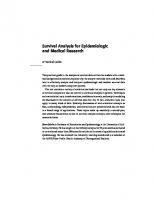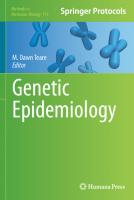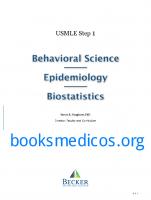Research Methods in Occupational Epidemiology (Monographs in Epidemiology and Biostatistics, Vol 13) [First Edition] 0195052242, 9780195052244
Occupational epidemiology has emerged as a distinct subdiscipline of epidemiology and occupational medicine, addressing
339 35 497KB
English Pages 368 [363] Year 1989
Table of contents :
Contents......Page 14
1. Overview......Page 22
2.1. Recognition of Occupational Diseases......Page 23
2.2. Development of Systematic Epidemiologic Methods......Page 25
3. Scope of Occupational Epidemiology......Page 26
3.1. Identifying Occupational Hazards and Populations at Risk......Page 28
3.2. Estimation of Effects......Page 30
3.3. Causal Inference......Page 32
References......Page 33
2. General Concepts of Exposure and Dose......Page 37
2.1. Definitions of Exposure and Dose Variables......Page 38
3.1. Industry-Based Studies......Page 40
3.2. Community-Based Studies......Page 54
4.1. Exposure Classification for Specific Biological Targets......Page 57
4.2. Combining Exposure Data from Various Sources......Page 59
5. Summary......Page 61
References......Page 62
2. Case Series......Page 65
3. Cohort Studies......Page 66
3.1. Prospective Cohort Studies......Page 67
3.2. Historical Cohort Studies......Page 70
3.3. Subcohort Analysis......Page 72
4. Case–Control Studies......Page 73
4.1. Industry-Based (Nested) Case–Control Studies......Page 74
4.2. Registry-Based Case–Control Studies......Page 75
5. Proportionate Mortality Studies......Page 77
6. Cross-Sectional Studies......Page 80
7. Connection Between Study Designs......Page 81
8. Summary......Page 86
Glossary......Page 87
References......Page 88
2.1. Precision......Page 91
3.1. Definition......Page 96
3.2. The Healthy Worker Effect......Page 97
3.3. Minimizing Selection Bias......Page 98
4.1. Nondifferential Information Bias......Page 99
4.2. Differential Information Bias......Page 101
4.3. Assessment of Information Bias......Page 102
5.1. Definition......Page 103
5.2. Relationship of Confounding to Selection and Information Bias......Page 104
5.3. The Healthy Worker Effect Revisited......Page 105
5.4. Other Confounders......Page 110
5.5. Assessment of Confounding......Page 111
5.6. Control of Confounding......Page 113
6.1. Joint Effects......Page 115
6.2. Effect Modification......Page 116
Glossary......Page 117
References......Page 118
2.1. Design Options: Prospective and Historical......Page 122
2.2. Defining and Following the Study Cohort......Page 124
3.1. Risks and Rates......Page 135
3.2. Stratum-Specific Rates......Page 140
3.3. Summary Measures of Effect......Page 141
4.1. Overall Cohort Analysis......Page 149
4.2. Subcohort Analysis......Page 155
4.3. Missing Exposure Data......Page 167
4.4. Disease Induction and Latency Analysis......Page 169
5. Planning a Cohort Study......Page 174
6.1. Description of the Plant and Study Cohort......Page 175
6.2. Vital Status Tracing and Cause of Death Determination......Page 176
6.3. Results......Page 177
7. Summary of Advantages and Limitations of Occupational Cohort Studies......Page 183
Notation......Page 184
References......Page 185
1. Overview......Page 189
2. Basic Study Design......Page 190
3. Selection of Cases......Page 191
4.1. Sampling Strategies......Page 193
4.2. Matching......Page 196
4.3. Sources of Controls......Page 198
4.4. Issues in Control Selection......Page 199
5. Exposure Data......Page 201
6.1. Crude Analysis......Page 203
6.2. Stratified Analysis......Page 205
6.3. Matched Analysis......Page 207
6.4. Extension to Multiple Exposure Levels......Page 209
7.1. Study Design......Page 211
7.2. Analysis: Dichotomous Exposure......Page 212
7.3. Analysis: Multiple Exposure Levels......Page 214
7.4. Discussion......Page 215
8. Summary of Advantages and Limitations of Case–Control Studies......Page 216
Notation......Page 217
References......Page 218
2. Study Design Features......Page 221
2.1. One-Time Surveys......Page 222
2.2. Repeated Surveys......Page 224
3.2. Exposure Data......Page 226
4.1. Plant- or Industrywide Studies......Page 227
4.2. Selection on Exposure Status......Page 229
4.3. Selection on Disease Status......Page 230
4.4. Comparison Populations......Page 231
5.1. Comparisons of Prevalence......Page 234
5.2. Comparisons of Physiologic Variable Distributions......Page 238
6.1. Temporal Relationship of Exposure to Disease......Page 242
6.3. Selection Bias......Page 243
6.4. Information Bias......Page 245
7.1. Data Requirements......Page 246
8. Summary of Advantages and Limitations of Occupational Cross-sectional Studies......Page 247
Glossary......Page 248
References......Page 249
2. Importance of Time-Related Analysis......Page 251
3. General Linear Models......Page 252
3.1. The Exponential Model......Page 253
3.2. Maximum Likelihood Estimation......Page 254
3.3. Other Models......Page 255
4.1. Poisson Regression......Page 256
4.2. The Proportional Hazards Model......Page 259
4.3. Logistic Regression......Page 260
5.2. Exposure......Page 262
5.3. Exposure–Response Estimation......Page 263
5.4. Confounding......Page 264
5.5. Joint Effects......Page 265
5.6. Regression Diagnostics......Page 266
6.2. Computational Methods......Page 269
6.4. Model Definition......Page 272
6.5. Comparison of Modeling Methods......Page 276
7. Summary of Advantages and Limitations of Modeling......Page 278
Notation......Page 279
References......Page 280
2. Fundamental Definitions of Exposure and Dose Parameters......Page 283
2.1. Exposure Variables......Page 284
2.2. Dose Variables......Page 285
3. Biomathematical Models of Organ Burden and Dose......Page 287
4.1. Example 1: Inhaled Soluble Uranium Compounds......Page 295
4.2. Example 2: Inhaled Asbestos Fibers......Page 299
5. Summary......Page 304
Glossary......Page 306
Notation......Page 307
References......Page 308
1. Overview......Page 310
2.1. Introduction......Page 312
2.3. Exposure Commencing Subsequent to Birth......Page 314
2.4. Fixed Duration of Exposure......Page 315
2.6. Implications......Page 317
3.1. Induction Time Analyses......Page 321
3.2. Relationship of Risk with Age at First Employment and Length of Follow-up......Page 323
3.3. Direct Fitting of the Armitage–Doll Model......Page 326
4. Introduction to Risk Assessment......Page 328
5. The Mathematics of Risk Assessment......Page 329
5.1. Dose–Response Models......Page 330
5.2. Lifetime Risk......Page 334
5.3. Probability of Causation......Page 337
6.1. The Dose–Response Curve......Page 340
6.2. Temporal Extrapolation......Page 342
6.3. Lifetime Risk......Page 343
6.4. Probability of Causation......Page 344
6.5. The No Observed Effects Level......Page 345
7. Discussion......Page 346
Notation......Page 348
References......Page 349
B......Page 352
C......Page 353
E......Page 355
F......Page 356
J......Page 357
M......Page 358
O......Page 359
P......Page 360
R......Page 361
S......Page 362
Y......Page 363
Contents......Page 14
1. Overview......Page 22
2.1. Recognition of Occupational Diseases......Page 23
2.2. Development of Systematic Epidemiologic Methods......Page 25
3. Scope of Occupational Epidemiology......Page 26
3.1. Identifying Occupational Hazards and Populations at Risk......Page 28
3.2. Estimation of Effects......Page 30
3.3. Causal Inference......Page 32
References......Page 33
2. General Concepts of Exposure and Dose......Page 37
2.1. Definitions of Exposure and Dose Variables......Page 38
3.1. Industry-Based Studies......Page 40
3.2. Community-Based Studies......Page 54
4.1. Exposure Classification for Specific Biological Targets......Page 57
4.2. Combining Exposure Data from Various Sources......Page 59
5. Summary......Page 61
References......Page 62
2. Case Series......Page 65
3. Cohort Studies......Page 66
3.1. Prospective Cohort Studies......Page 67
3.2. Historical Cohort Studies......Page 70
3.3. Subcohort Analysis......Page 72
4. Case–Control Studies......Page 73
4.1. Industry-Based (Nested) Case–Control Studies......Page 74
4.2. Registry-Based Case–Control Studies......Page 75
5. Proportionate Mortality Studies......Page 77
6. Cross-Sectional Studies......Page 80
7. Connection Between Study Designs......Page 81
8. Summary......Page 86
Glossary......Page 87
References......Page 88
2.1. Precision......Page 91
3.1. Definition......Page 96
3.2. The Healthy Worker Effect......Page 97
3.3. Minimizing Selection Bias......Page 98
4.1. Nondifferential Information Bias......Page 99
4.2. Differential Information Bias......Page 101
4.3. Assessment of Information Bias......Page 102
5.1. Definition......Page 103
5.2. Relationship of Confounding to Selection and Information Bias......Page 104
5.3. The Healthy Worker Effect Revisited......Page 105
5.4. Other Confounders......Page 110
5.5. Assessment of Confounding......Page 111
5.6. Control of Confounding......Page 113
6.1. Joint Effects......Page 115
6.2. Effect Modification......Page 116
Glossary......Page 117
References......Page 118
2.1. Design Options: Prospective and Historical......Page 122
2.2. Defining and Following the Study Cohort......Page 124
3.1. Risks and Rates......Page 135
3.2. Stratum-Specific Rates......Page 140
3.3. Summary Measures of Effect......Page 141
4.1. Overall Cohort Analysis......Page 149
4.2. Subcohort Analysis......Page 155
4.3. Missing Exposure Data......Page 167
4.4. Disease Induction and Latency Analysis......Page 169
5. Planning a Cohort Study......Page 174
6.1. Description of the Plant and Study Cohort......Page 175
6.2. Vital Status Tracing and Cause of Death Determination......Page 176
6.3. Results......Page 177
7. Summary of Advantages and Limitations of Occupational Cohort Studies......Page 183
Notation......Page 184
References......Page 185
1. Overview......Page 189
2. Basic Study Design......Page 190
3. Selection of Cases......Page 191
4.1. Sampling Strategies......Page 193
4.2. Matching......Page 196
4.3. Sources of Controls......Page 198
4.4. Issues in Control Selection......Page 199
5. Exposure Data......Page 201
6.1. Crude Analysis......Page 203
6.2. Stratified Analysis......Page 205
6.3. Matched Analysis......Page 207
6.4. Extension to Multiple Exposure Levels......Page 209
7.1. Study Design......Page 211
7.2. Analysis: Dichotomous Exposure......Page 212
7.3. Analysis: Multiple Exposure Levels......Page 214
7.4. Discussion......Page 215
8. Summary of Advantages and Limitations of Case–Control Studies......Page 216
Notation......Page 217
References......Page 218
2. Study Design Features......Page 221
2.1. One-Time Surveys......Page 222
2.2. Repeated Surveys......Page 224
3.2. Exposure Data......Page 226
4.1. Plant- or Industrywide Studies......Page 227
4.2. Selection on Exposure Status......Page 229
4.3. Selection on Disease Status......Page 230
4.4. Comparison Populations......Page 231
5.1. Comparisons of Prevalence......Page 234
5.2. Comparisons of Physiologic Variable Distributions......Page 238
6.1. Temporal Relationship of Exposure to Disease......Page 242
6.3. Selection Bias......Page 243
6.4. Information Bias......Page 245
7.1. Data Requirements......Page 246
8. Summary of Advantages and Limitations of Occupational Cross-sectional Studies......Page 247
Glossary......Page 248
References......Page 249
2. Importance of Time-Related Analysis......Page 251
3. General Linear Models......Page 252
3.1. The Exponential Model......Page 253
3.2. Maximum Likelihood Estimation......Page 254
3.3. Other Models......Page 255
4.1. Poisson Regression......Page 256
4.2. The Proportional Hazards Model......Page 259
4.3. Logistic Regression......Page 260
5.2. Exposure......Page 262
5.3. Exposure–Response Estimation......Page 263
5.4. Confounding......Page 264
5.5. Joint Effects......Page 265
5.6. Regression Diagnostics......Page 266
6.2. Computational Methods......Page 269
6.4. Model Definition......Page 272
6.5. Comparison of Modeling Methods......Page 276
7. Summary of Advantages and Limitations of Modeling......Page 278
Notation......Page 279
References......Page 280
2. Fundamental Definitions of Exposure and Dose Parameters......Page 283
2.1. Exposure Variables......Page 284
2.2. Dose Variables......Page 285
3. Biomathematical Models of Organ Burden and Dose......Page 287
4.1. Example 1: Inhaled Soluble Uranium Compounds......Page 295
4.2. Example 2: Inhaled Asbestos Fibers......Page 299
5. Summary......Page 304
Glossary......Page 306
Notation......Page 307
References......Page 308
1. Overview......Page 310
2.1. Introduction......Page 312
2.3. Exposure Commencing Subsequent to Birth......Page 314
2.4. Fixed Duration of Exposure......Page 315
2.6. Implications......Page 317
3.1. Induction Time Analyses......Page 321
3.2. Relationship of Risk with Age at First Employment and Length of Follow-up......Page 323
3.3. Direct Fitting of the Armitage–Doll Model......Page 326
4. Introduction to Risk Assessment......Page 328
5. The Mathematics of Risk Assessment......Page 329
5.1. Dose–Response Models......Page 330
5.2. Lifetime Risk......Page 334
5.3. Probability of Causation......Page 337
6.1. The Dose–Response Curve......Page 340
6.2. Temporal Extrapolation......Page 342
6.3. Lifetime Risk......Page 343
6.4. Probability of Causation......Page 344
6.5. The No Observed Effects Level......Page 345
7. Discussion......Page 346
Notation......Page 348
References......Page 349
B......Page 352
C......Page 353
E......Page 355
F......Page 356
J......Page 357
M......Page 358
O......Page 359
P......Page 360
R......Page 361
S......Page 362
Y......Page 363
![Research Methods in Occupational Epidemiology (Monographs in Epidemiology and Biostatistics, Vol 13) [First Edition]
0195052242, 9780195052244](https://ebin.pub/img/200x200/research-methods-in-occupational-epidemiology-monographs-in-epidemiology-and-biostatistics-vol-13-first-edition-0195052242-9780195052244.jpg)
- Author / Uploaded
- Harvey Checkoway
- Neil Pearce
- Douglas J. Crawford-Brown
- Similar Topics
- Biology
- Biostatistics



![Human Genome Epidemiology: A Scientific Foundation for Using Genetic Information to Improve Health and Prevent Disease (Monographs in Epidemiology and Biostatistics) [1 ed.]
0195146743, 9780195146745, 9781423775645](https://ebin.pub/img/200x200/human-genome-epidemiology-a-scientific-foundation-for-using-genetic-information-to-improve-health-and-prevent-disease-monographs-in-epidemiology-and-biostatistics-1nbsped-0195146743-9780195146745-9781423775645.jpg)



![Biostatistical Methods in Epidemiology [1 ed.]
0471369144, 9780471369141, 9780471461609](https://ebin.pub/img/200x200/biostatistical-methods-in-epidemiology-1nbsped-0471369144-9780471369141-9780471461609.jpg)

![Methods in Field Epidemiology [1 ed.]
0763784591, 9780763784591](https://ebin.pub/img/200x200/methods-in-field-epidemiology-1nbsped-0763784591-9780763784591.jpg)